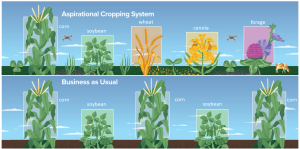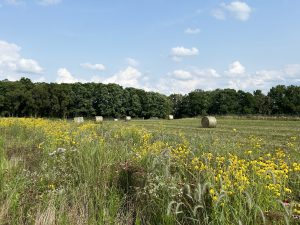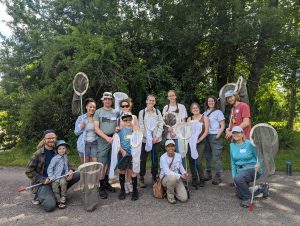KBS has always been committed to creating spaces for education and outreach to the wider community.
Much of the research and community engagement work at KBS is funded by the National Science Foundation, which places a strong emphasis on how projects plan to share research findings in ways that benefit society. These effects beyond the scientific community are called “Broader Impacts”.
Engaging the community is a collective effort from across KBS, including the Bird Sanctuary, Long-Term Ecological Research—LTER—and Long-Term Agroecosystem Research—LTAR—programs, Kellogg Conference Center & Manor House, and the facilities, grounds, and custodial crews.
Social and digital interactions

In 2023, the KBS LTAR held its first-ever field day in partnership with MSU Extension. More than 90 people attended the daylong program. KBS researchers and staff shared research about the “Common Experiment,” a study across LTAR sites that compares conventional and aspirational agricultural practices, looking at differences in profitability, drought resilience, soil health, and precision technology which allows for alternate plantings, such as prairie strips, in low-yield areas. Importantly, field day attendees were able to speak about their experiences and suggest ideas for additional study topics that LTAR might pursue.
This year, the KBS LTER program, together with MSU Extension and MiSTRIPS (the Michigan chapter of the Science-based Trials of Rowcrops Integrated with Prairie Strips program), developed a new tool to help farmers estimate the cost to convert cropland to prairie strip plantings.

The tool helps producers determine whether marginally productive areas—often field borders or low-lying areas—cost more to plant with crops than to restore to prairie. Findings reveal that planting prairie strips could save farmers money if planted in areas where crops yield below 50% of the statewide average.
The practice of converting up to 10% of cropland to a mixture of perennial, native plants is gaining traction in Michigan. Prairie strips have been shown to reduce nutrient leaching, provide habitat for pollinators and prevent soil erosion, all without reducing crop yields near the prairie strip.
“This new tool predicts that prairie strips could save farmers money if planted in areas where crops yield below 50% of the statewide average,” said KBS-based graduate student Rachel Drobnak who worked with a team of more than a dozen faculty, staff and students to create the interactive spreadsheet.
Blending art and science
After three years of offering a nature journaling course through the Kellogg Bird Sanctuary, KBS staff and several current and former outreach fellows published an article in a special issue of the Plant Science Bulletin, which detailed the development and facilitation of that course.

The courses begin with a presentation on basic ecological principles and then focus on drawing techniques using a certain species or community of species.
In part, the article said, “Nature journaling invites us to connect with our curiosity for the natural world by keeping records of our observations. Documentation can include words, numbers, sketches, diagrams, photos, collage, maps, and found objects. Anyone—even those not trained in art or science—can use nature journaling to cultivate mindfulness and wonder, build critical thinking skills, develop greater perception, and deepen their understanding of the environment.”
The article was written by Dr. Corinn Rutkoski, Robin Waterman, Misty Klotz, Dr. Meredith Zettlemoyer, and Taylor Scamehorn.
Community science at the Sanctuary

The KBS BioBlitz completed its second year in 2024. More than 125 participants gathered to photograph species in certain categories—such as prairie plants, insects, birds, reptiles and amphibians—and added their observations to the iNaturalist app. In 2024 alone, the BioBlitz documented 174 species of insects, and almost 400 species overall, with more than 1,000 total observations on iNaturalist.
The first BioBlitz, held in June 2023, also drew more than 100 people, from toddlers to retirees.
Dr. Alisha Shah, a resident faculty member at KBS, will use data collected over five annual BioBlitz events to track the number of insect species and their abundance at the Bird Sanctuary. These large datasets, collected over multiple years, will be compared to local climate patterns to measure how insects respond to ongoing climate change.
We invite you to join us for the third annual KBS BioBlitz on June 14, 2025!
~~~~~~~~~~~~~~~~~~~~
This feature is an excerpt from the 2023-24 KBS Annual Report. Read the full report here.
~~~~~~~~~~~~~~~~~~~~

A legacy of conservation; a commitment to sustainability.
3700 E. Gull Lake Drive
Hickory Corners, MI 49060
(269) 671-5117
info@kbs.msu.edu